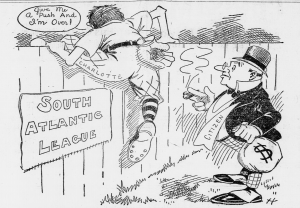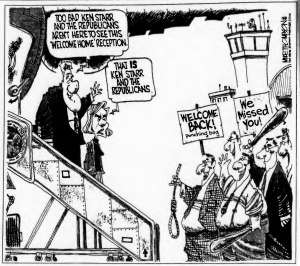 A cartoon showing a white journalist and a Black journalist writing at their desks but connected by their backs. Above them, a portrait of Thomas Jefferson is vomiting." />
A cartoon showing a white journalist and a Black journalist writing at their desks but connected by their backs. Above them, a portrait of Thomas Jefferson is vomiting." />One of the ways that newspaper publishers express their views is through political cartoons. This editorial form became popular over the 20th century for the way it can quickly and forcefully deliver a viewpoint to its audience—particularly in decades when not all adults could read. This primary source set uses examples of political cartoons from school and community newspapers to show how the form has evolved over the last 100 years.
 A cartoon showing a white journalist and a Black journalist writing at their desks but connected by their backs. Above them, a portrait of Thomas Jefferson is vomiting." />
A cartoon showing a white journalist and a Black journalist writing at their desks but connected by their backs. Above them, a portrait of Thomas Jefferson is vomiting." />













Many newspapers in the 20th and 21st centuries include editorial sections designed to make arguments or give opinions about topics in the news. One way for newspaper editors to present an opinion is through political cartoons. While these cartoons can be funny and entertaining, their primary purpose is to quickly make an argument about a political or social issue. Political cartoons can be found in all kinds of newspapers published in many different countries and can be used to address any issue that the audience of the newspaper recognizes. Many times, the artists address polarizing issues with cartoons or push the boundaries in an effort to evoke a reaction from readers.
Political cartoons often use some of the same rhetorical devices as written articles, including irony, symbolism, and analogy. Cartoons also have their own rhetorical devices, such as exaggerating characteristics of a particular person and labeling things to tell you what they represent. Sometimes, the meaning of the cartoon is made clear through a short title or caption. Additionally, understanding political cartoons usually requires knowing their contexts. Many of them contain representations of famous people or references to historical events. It may also help to know the intended audience of the newspaper.
Note: Some political cartoons depict stereotypes that may be uncomfortable to see. While the examples in this set avoid offensive imagery as much as possible, other pages of these newspapers may include it.